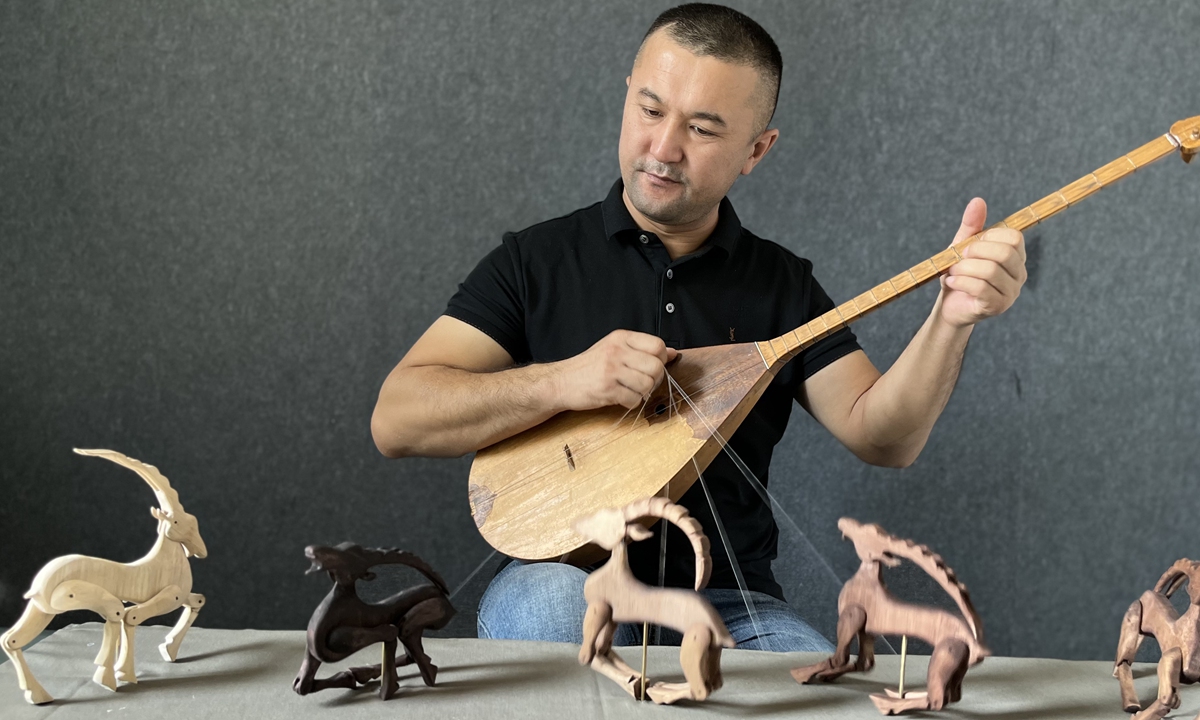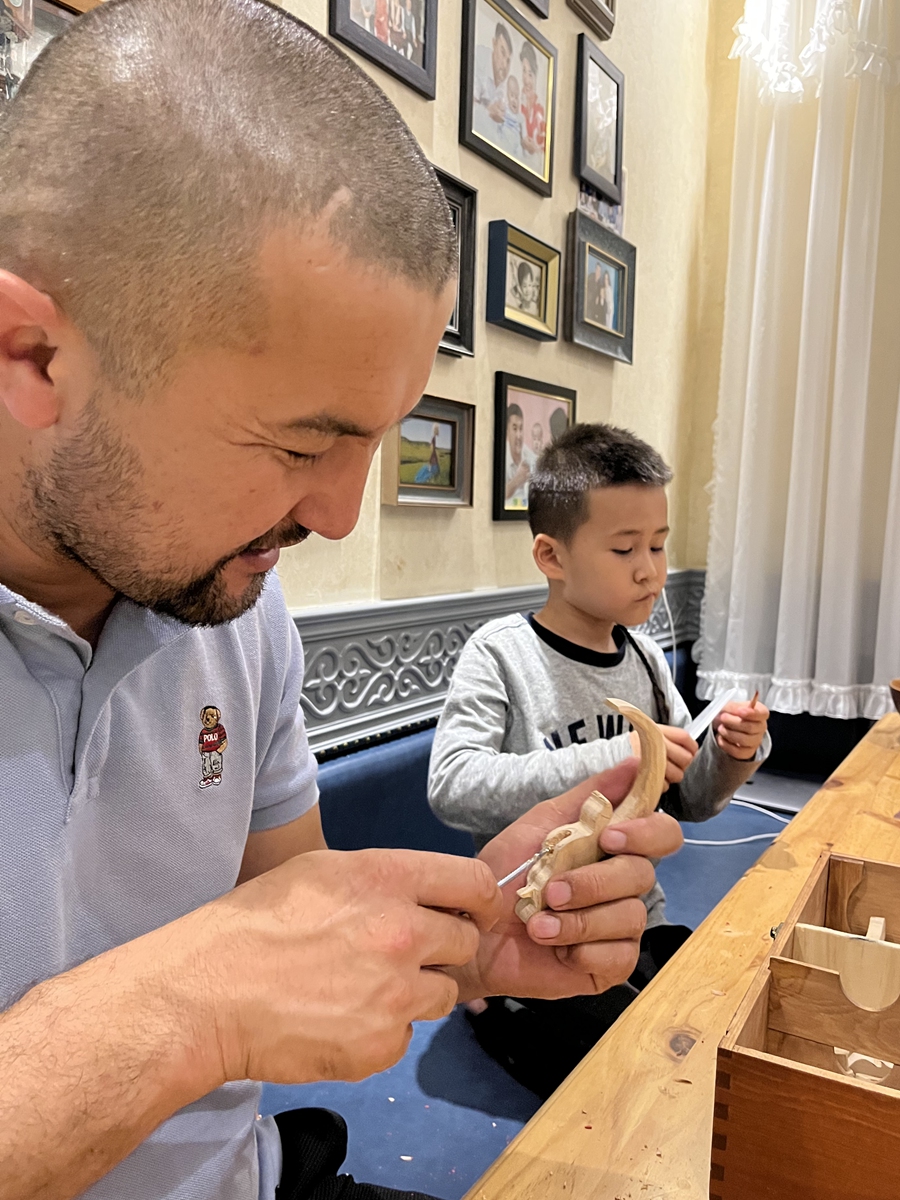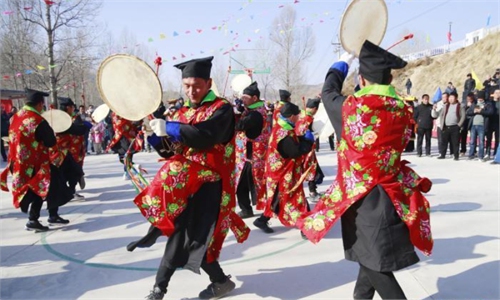ARTS / ART
Young vlogger in Xinjiang region keeps ethnic traditional art alive
Dancing to an ancient beat

Orteke performer Ahl. Satiken Photo: Courtesy of Ahl. Satiken
Living in Urumqi, capital of Northwest China's Xinjiang Uygur Autonomous Region, voice over actor Ahl. Satiken never expected that among the many short videos he has shared on the internet about Kazak culture, a traditional puppet dance known as "Orteke" would capture so much attention, causing many netizens to comment that "the culture of China's minority groups is truly eye opening."
Dance of the red goats
Orteke (lit: dark-red goat) is an ancient Kazak performance art that sees a puppeteer make handmade wooden goat puppets dance to the plucked musical instrument known as the dombra.
In his short video that has received around 100,000 likes on Douyin, the Chinese regional version of TikTok, the multi-talented Satiken plays the dombra as he controls the movement of five goat puppets by pulling thin silk strings twisted around this fingers, making them dance up and down to the music.
"These goat puppets can eat grass, grind their horns and even use their horns to butt people. The secret lies in controlling how strongly you pull the strings according to the tempo of the music," Satiken told the Global Times.
Although he calls himself an amateur at the art, the 37-years-old Orteker told the Global Times that he first learned his puppetry skills from his grandpa when he was 11 years old.
"Ethnic culture accompanied me as I grew up in my village [in the Mori Kazak Autonomous county]," Satiken said.
"I'm proud of my cultural roots, so I fell for it."
Satiken told the Global Times that in order to get more people from different cultural backgrounds on the internet interested in this ingenious ethnic art, he made some tweaks to traditional Orteke.
Compared to the original version, Satiken's Douyin Orteke has added a stage so his tiny performers can dance better.
But what hasn't changed is that the goat puppets are still handmade.
"I see a lot of people on the internet embracing the cultures of Xinjiang. I guess this shows that the region's diverse ethnic cultures are all celebrated as gems of Chinese culture," Satiken remarked.
"Please send this show to the Spring Festival Gala!" one netizen commented on Satiken's short video. Held every year, the Spring Festival Gala is the biggest televised performance in China and traditionally exhibits the country's diverse culture to viewers in China and around the world.
Knitting a cultural web
Satiken is not the only contemporary performer who has dedicated himself to keeping traditional Orteke up to date.
Tumar, a five-member music band from Xinjiang's Altay Prefecture, has also interwoven the art of Orteke into their music, combining it with another Kazak ethnic treasure known as khoomei, a type of throat singing that vividly mimics the sounds of nature.
"People in China's Xinjiang Uygur Autonomous Region have absorbed a diverse array of ethnic cultures, turning them into an 'expression of belief' on nature, heroism and solidarity," Wang Xuming, a Chinese ethnic minority culture researcher, noted to the Global Times.
"Using culture and art to express faith and hope has always been a Chinese tradition," Wang noted.
Orteke, an intangible cultural heritage of the Altay Prefecture, has also been incorporated into the educational system of Xinjiang.
The art's inheritors and enthusiasts in more than 20 county-level and district-level places in Xinjiang participated in training classes held at Habahe county in early September.
"Training classes are like knitting a cultural web. Training such as this will help more young people become interested in the art form while inheritors that have finished training can further influence their peers," Wang noted.
Staying up late to play with his goat puppets sometimes until 4 am, Satiken is a diligent Orteke performer who says he never feels tired when doing the things he loves and that he will continue to use social media as a tool to promote his ethnic culture.
"What I want to do is get as many people as possible to learn about this magical and ancient art, so that they can have a chance to come into contact with it," he said.

Ahl. Satiken and his son Angebay make wooden goat puppets. Photo: Courtesy of Ahl. Satiken
Just as his grandfather once inspired him, Satiken plays for his 6-year-old son Angebay, who often watches him perform and design puppets. Sometimes Angebay even gives his father advice on the goat puppet designs as a "toy expert."
"Currently, the Orteke puppets at our home have become his best playmates. I hope when he grows up, even if he does not want to become a puppeteer, he can still respect and recognize his cultural roots," Satiken said.

